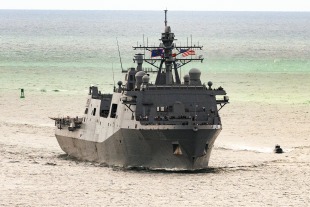Amphibious transport dock USS Richard M. McCool Jr. (LPD-29)
Classification
Basic information
Ship measurements
Machine
- 4 * Colt-Pielstick diesel engines, two shafts, 40,000 hp (30 MW)
Personnel
Combat assets
- 2 * LCACs (air cushion)
- or 1 * LCU (conventional)
- AN/SPS-73(V)18 — Next Generation Surface Search Radar; AN/SPY-6(V)2 EASR Rotating Radar
- 2 * 30 mm Bushmaster II cannons, for surface threat defense;
- 2 * Rolling Airframe Missile launchers for air defense
- 4 * CH-46 Sea Knight helicopters or 2 * MV-22 tilt rotor aircraft may be launched or recovered simultaneously
USS Richard M. McCool Jr. (LPD-29) is the 13th and final Flight I San Antonio-class amphibious transport dock of the United States Navy. She is named after US Navy officer and Medal of Honor recipient Richard M. McCool, Jr. Richard M. McCool Jr. was built by Ingalls Shipbuilding in Pascagoula, Mississippi. She was christened on 11 June 2022, formally delivered to the US Navy on 11 April 2024, and commissioned on 7 September 2024.
Like her immediate predecessor, USS Fort Lauderdale (LPD 28), Richard M. McCool Jr. will be a «transitional ship» between the current San Antonio-class Flight I design and future Flight II vessels, starting with USS Harrisburg (LPD 30), and as such will feature design improvements developed in connection with the Navy's development of the LX(R)-class amphibious warfare ship, (which is intended to replace the current Whidbey Island-class and Harpers Ferry-class dock landing ships). Richard M. McCool Jr. incorporates the changes that will be introduced in Fort Lauderdale intended to reduce the cost compared to the San Antonio-class, including: simplified bow works, replacement of the forward and aft composite masts with steel masts, removal of structures from the boat valley, and a stern gate which is open at the top. In addition, unlike Fort Lauderdale, Richard M. McCool Jr. will use the Enterprise Air Surveillance Radar (EASR) volume air search radar.
- Comments
 en
en ru
ru uk
uk



 United States Navy
United States Navy Ingalls Shipbuilding
Ingalls Shipbuilding